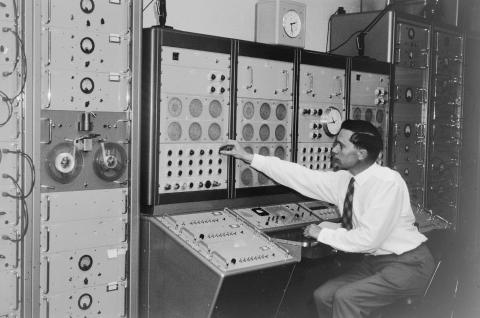Submitted by Richard Ordish on Thu, 05/09/2019 - 12:18
Members of the Laboratory will be saddened to learn of the death of Dr. Bruce Elsmore on 24 August 2019. In 1948 Bruce joined the fledgling radio astronomy group led by Martin Ryle which brought the discipline of radio astronomy into being just after the War. Bruce’s practical skills in the design and construction of radio receivers, and the operation in the field of aperture synthesis radio telescopes made an enormous contribution to the rapid development of radio astronomy at Cambridge.
Bruce at the control panel of the One-Mile Telescope.

His name is particularly associated with the first paper on Earth-rotation aperture synthesis observations with the Cambridge One-Mile Telescope of the radio sources Cygnus A and Cassiopaeia A (Ryle, Elsmore and Neville 1965). Those of us present at the time were startled by the unprecedented quality of these radio images, both in sensitivity and angular resolution. These and subsequent observations with the One-Mile Telescope and the subsequent 5-km telescope put Cambridge and the UK in the leading position in radio astronomical imaging world-wide. It also resulted in Martin Ryle’s Nobel Prize in Physics in 1974. Bruce was also the Group’s guru in the somewhat less glamorous subject of radio astrometry, the precise measurement of radio source positions on the sky. By using quasars as calibrators, this became the preferred means of establishing the astrometric frame of reference for all astronomy.
Bruce was a fellow of St. Edmunds College and served as Senior Tutor from 1978 to 1989. He served selflessly, loyally, and enthusiastically six Masters of the College. We all remember his quiet kindness and gentle support through what were dramatic and, at times, turbulent years in the history of radio astronomy.
We send our condolences to his wife Annette and their family.
